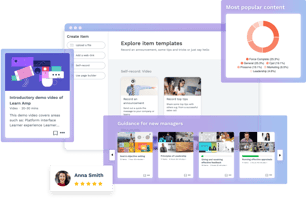So, you’ve decided your company needs a new learning management system (LMS).
Whether you're tech company with development know-how, or an enterprise company confident of your ability to fund a solution, your C-suite and IT teams will likely be facing a common dilemma...
...Should you implement an existing solution on the market, or develop a custom solution in-house?
Whether you decide to build or buy LMS software, there are benefits and downsides to weigh up.
Cost, convenience, compatibility and the capacity to manage the platform are all key considerations.
But if you think building an LMS is the way to go, think carefully.
In this article, we’ll examine the case for and against building an LMS.
We’ll also explain how you can buy an LMS and still tailor it to your unique needs - at a fraction of the cost and hassle of building in-house.
The pros and cons of building an LMS
If money were no object, and you had all the time and knowledge you needed, building the perfect LMS could seem like the ideal solution.
But the reality is, building enterprise software is a huge undertaking, no matter how big your budget, or how much in-house software development talent you boast.
Before you choose to go that route, let’s look at the advantages and disadvantages of building a custom learning platform.
The pros
- Look and feel: It's your software and you can make it your own. Not tied to a supplier’s user interface, you can offer users a consistent user experience that matches other apps you already use.
- What you need, not what you don’t: You can choose exactly the tools and features to include. You’re not paying for features you don’t want or won’t use. And you don’t need to compromise on the nice-to-have features.
- Full control: When it comes to administration and managing software updates and upgrades, you’re not beholden to third-party support. You’re in the driver’s seat.
The cons
- Distraction: to do it well you need to commit a lot of time, energy and focus on the development and maintenance of your application. Time spent on tech will distract you away from your own business and being the best you can be for your customers.
- Falling behind: As being an LMS company is not your core business you are likely not going to be able to commit resource to consistent development and innovation. You will eventually fall behind the industry standard. This will affect the 'people product', or EVP, you offer your employees. Which will put you at risk of not attracting, engaging or retaining talent.
- Risk: All information and the associated risks are kept in-house and under your remit, rather than being outsourced to third parties. Some may think this is a pro but in reality it means it's your responsibility to protect the integrity of the application and your users' data. Can you keep up in the never ending cyber security race?
Buying an LMS actually saves you time and money
No, really! Buying an off-the-shelf solution is cheaper and less time-consuming than building one.
For one thing, you can install a SaaS (software as a service) LMS and get it up and running within weeks as part of a supported implementation process.
For another, you’re not simply buying a product, you’re also paying for a service.
You are paying to not have the hassle and cost of all that maintenance, bug fixes, tech support, cyber security, product development, and innovation. Your service provider takes care of that for you.
So, how much does an LMS cost?
A cloud-based learning management system will typically include license/user fees and implementation fees, plus costs for any additional bolt-on services you have opted for.
The cost of implementation is dependent on the complexity of your project, but you can expect to see a range from £3,000 to £35,000.
And then license fees - which should not just cover access, but also data hosting, tech support, and software updates and upgrades - can range from £10 to £100 per year per user, depending on the breadth of the product and the number of users.
Markedly better value than building.
But what about that all-important flexibility?
If you still need a bespoke, customisable solution, but the costs and commitments of building an LMS are making your eyes water, fear not.
Times and tech have changed.
In the past, buying an off-the-shelf LMS meant compromising on flexibility and customisation.
But today’s SaaS LMS offers flexible solutions that can be adapted to suit each business and each user.
The best LMS platforms come with plenty of choices for adapting to your needs and tastes.
Think of it as creating an à la carte pizza with your favourite toppings, instead of choosing from a set menu 🍕
1. Choose your baseThis is your SaaS vendor. You’ll be relying on the expertise of your vendor to support you not just during implementation, but beyond. Who would make the best partner for your business based on factors such as alignment with your L&D methodology and strategic roadmap?
2. Choose your main ingredients
What tools and features does your LMS absolutely need? These might include off-the-shelf eLearning, content creation and curation tools, assessment tools and reporting tools.
3. Choose your additional toppings
What optional add-ons will really engage and even entertain learners, so that they want to use it? This could be community management, skills mapping, you name it!
And the pricing is à la carte too 👨🍳
Learn Amp, for example, tailors its pricing based on whether you add social learning or performance management tools, like OKRs and 1-to-1s.

|
For the best value-for-money LMS, buy and customise.
A great learning platform goes beyond a simple off-the-shelf LMS.
It gives you the freedom to choose from a menu of add-ons when and if you are ready to use them.
It should also allow you to integrate with ease into your wider HRTech stack such as HRIS and communication tools for a cohesive, all-round employee experience - without having to start from scratch.
But how to find the right LMS for your business?
One useful guide is the Fosway Group 9-GRID™. This compares learning systems and providers based on their potential, performance, total cost, market presence, and future trajectory.
But all of this expert commentary is only useful if you are confident in your requirements.
How do you know if you need an enterprise-scale HCM platform, a solid high-performing L&D suite that can grow with you, or a niche specialist platform?
To help you think through all of this, check out our guide to selecting a new LMS.
This provides a comprehensive roadmap to selecting, customising, and implementing a learning platform—complete with checklists and a question bank for assessing LMS vendors.
And to find out why Learn Amp has been named the No.2 Learning System of 2023, talk to our experts.

|



